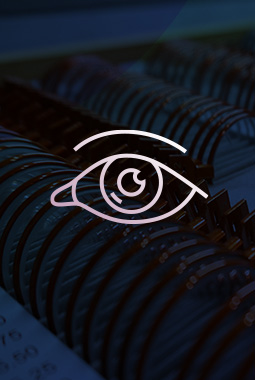Irritating, Uncomfortable Eyes
We use our eyes all day long, but we rarely think of them unless they’re uncomfortable—and then they’re all we think about. Adults might turn to redness-relieving eye drops, while kids often rub their eyes. But neither strategy tackles the true cause of tired, scratchy eyes.
Dry eye is a chronic, common, and uncomfortable condition impacting around 6 million Canadians. Not only is it irritating, but it can really put a damper on your daily activities. Dry eyes can decrease your quality of life and lower productivity.
But relief is available! Book an appointment today for a comprehensive eye exam to diagnose your dry eye. If left untreated, dry eye can lead to long-term infections and eye damage down the road. Anytime your eyes are uncomfortable, it’s best to pay us a visit and rule out more worrisome conditions.
Book Appointment OnlineSymptoms of Dry Eye
Dry eye symptoms generally occur in both eyes at the same time and can include:
- Stinging or burning
- Gritty or scratchy feeling
- Foreign body sensation
- Red or watery eyes
- Blurry vision
- Sensitivity to light
- Eye fatigue
- Stringy mucus in or around your eyes
- Discomfort when wearing contacts
If you are experiencing any of these symptoms, book your appointment to explore dry eye treatment options today.
What Is Dry Eye?
Dry is exactly what it sounds like—it occurs when your eyes aren’t producing enough lubrication to keep them moist and comfortable.
There are 2 main types of dry eye. The first—and least common—occurs when the eyes simply don’t produce enough tears. The second occurs when the tears are of poor quality.
Decreased Tear Production
Reasons for decreased tear production are varied and might include:
- Contact lens wear
- Normal aging
- Medications such as antihistamines or antidepressants
- Medical conditions such as lupus, rheumatoid arthritis, or Sjögren’s Syndrome
- Recent laser vision correction surgery
Poor Quality Tears
Good-quality tears depend on a balanced and effective tear film. The tear film is made up of 3 layers—a mucus layer to spread the tears over the surface of the eye, a water layer to hydrate the eye, and an oil layer to keep the water from evaporating too quickly. If there’s an imbalance in the tear film, dry eye can result.
The tiny glands along the top and bottom edges of the eyelids, called the meibomian glands, are responsible for producing the oil layer of your tear film. Blockages in these glands can cause a reduction in the amount of oil produced, leading to dry eyes.
When we diagnose your dry eye, we’ll also look at the condition of your meibomian glands and recommend treatment options if they’re not functioning properly.
Our Dry Eye Treatments
Dry eye can interfere with daily tasks like reading, driving, or spending time on digital devices. Because no 2 cases of dry eye are the same, we continue to invest in technology and new treatment options that allow us to customize care for each patient.
Our goal is not only to relieve symptoms but also to address the underlying cause, protect long-term eye health, and restore quality of life.
Punctal Plugs
Punctal plugs are tiny, biocompatible devices inserted into the tear ducts to slow tear drainage. By helping your natural tears stay on the eye’s surface longer, they can provide quick, lasting relief.
Safe and reversible, punctal plugs are an effective option for patients needing extra tear support.
Amniotic Membranes
Amniotic membranes are biologic lenses placed on the eye to reduce inflammation and promote healing. They support cell regeneration on the eye’s surface, making them especially helpful for patients with persistent or more advanced dry eye.
Meibography
A meibography gives us a clear image of your meibomian glands, which produce the oils that keep tears from evaporating. This detailed imaging helps us identify gland blockages or damage so we can create a treatment plan tailored to your needs.
Upgraded Diagnostic Technology
We’ve recently introduced new digital slit lamps, including the S390L Firefly slit lamp, to enhance how we diagnose and monitor dry eye.
These advanced instruments provide high-resolution imaging and video, allowing our team to capture detailed views of the eye’s surface and tear film.
With this clearer perspective, we can track changes over time, make more accurate assessments, and tailor treatments more effectively. For patients, this means faster answers, precise care, and greater peace of mind.
Finding Relief From Dry Eye
No matter the cause of your dry eye, relief is available. We offer customized treatment options tailored to your unique needs. Start on the path to clear, comfortable vision today!
Book Appointment OnlineOur Location
Visit Us
Find us on the corner of Main Street and Beaver Lake Road. We are accepting new patients and looking forward to welcoming you and your family.
Our Address
- 49-9522 Main Street
- Lake Country, BC V4V 2L9
Contact Information
- Phone: 250-766-4240
- Fax: 250-766-4267
- Email: [email protected]
Our Hours
- Monday: 9:00 AM – 5:00 PM
- Tuesday: 9:00 AM – 5:00 PM
- Wednesday: 8:00 AM – 7:00 PM
- Thursday: 9:00 AM – 5:00 PM
- Friday: 9:00 AM – 5:00 PM
- Saturday: 9:00 AM – 3:00 PM
- Sunday: Closed
Our Brands





Frequently Asked Questions
Can you make glasses with an external prescription?
Yes, we accept all prescriptions for glasses that have not expired. If your prescription is expired or you need to have your prescription assessed, we are more than happy to book you an appointment with one of our doctors for an exam.
How long does it take for glasses to arrive?
We make glasses in-house, and it takes around 3 hours for us to edge the lenses into your frame of choice. If glasses need to be ordered in, they typically take around 7 to 10 business days. Specialty orders may take longer to arrive. Our optical will do our best to give you an accurate time estimate and have your glasses made as soon as we can.
What is included in a full eye exam?
A full eye exam includes the following:
-
- A comprehensive ocular and medical history check-up to identify or assess your risk factors for certain eye diseases
-
- A vision check and prescription for glasses, if warranted
-
- Binocular vision testing to check how your eyes are functioning together
-
- A measurement of intraocular pressure (IOP) on all patients
-
- An optomap scan of your retina on all patients
-
- An OCT (optical coherence tomography) scan for adults
-
- A comprehensive eye health check in the office by the doctor
-
- If warranted, your eye doctor may recommend a visual field test to better assess peripheral vision in association with the use of medications with risk of harmful effects on vision
What is the cost of an eye exam?
Children (18 and under), seniors (65+), or those with certain medical conditions are eligible for medical services plan (MSP) coverage. MSP covers part of the eye exam and visual field tests (think of it like insurance), lowering the total cost of the exam you/your insurance is responsible for. We do not charge for children age 2 and under.
A patient is NOT eligible for MSP coverage if:
- You are from out of province
- Not registered with BC medical
- If you have had an eye exam elsewhere within the past year
| Service | Full Cost | If MSP Billable |
| Adult Eye Exam (19+) | $162 | $115 |
| Adult Contact Lens Wearer Eye Exam (19+) | $177 | $130 |
| Child Eye Exam (2-18) | $85 | $30 |
| Child Contact Lens Wearer Eye Exam (2-18) | $100 | $45 |
Do you do LASIK co-management?
Yes, we are more than happy to be a part of your LASIK journey. We are pleased to offer post-op follow-ups.
Can you direct bill my insurance?
Yes, we can directly bill most insurance companies. If your insurance company is not eligible for direct billing, we will provide you with a detailed receipt to submit for reimbursement.
What do I need to bring to my eye exam?
Please bring a list of medications, your glasses and contact lenses (or your last prescription), and any forms that need to be completed.
How long is an eye exam?
Full eye exams are usually between 30 to 45 minutes.
Do I have to be dilated during the exam?
Our office offers wide-field retinal imaging with the optomap machine on all patients who are physically able to. The optomap scan provides a 200-degree image of the retina (inside lining of the eye).
In certain cases, dilation is still recommended to better assess the retina and check for cataracts and other ocular diseases. If you are dilated, we encourage bringing a driver with you so you feel more safe on the way home.






